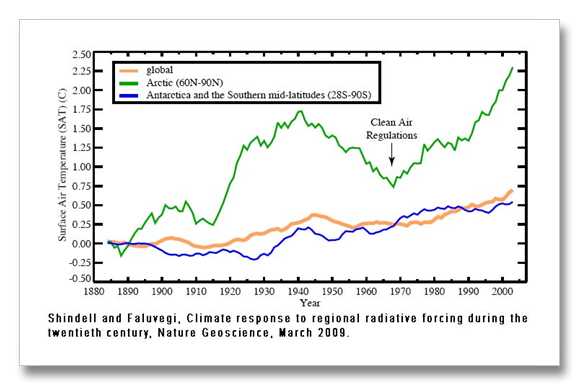The major aerosols are black carbon (see May 7), sulfates and oxides of nitrogen (NOx). They come from combustion. Black carbon comes mostly from the burning of most fuels in developing and third world nations where pollution controls are not as stringent as in the developing world. Sulfates and NOx comes mostly from coal and oil and again, less in the developed world because of more stringent pollution controls.
We have found in the last few years that aerosols are nearly comparable to greenhouse gases when understanding how our atmosphere responds to warming energy from the sun. NASA scientists have published research findings in the journal Nature Geoscience that show that aerosols, including black carbon, have now been shown to account for 45% of recent warming in the Arctic.
It all started with the industrial revolution. Greenhouse gases and aerosols from coal and oil burning started to warm the planet. The warming was amplified then, as it is now, by the polar amplification effect. World War I put a stop to the warming; likely the complicated effects of aerosol pollution were responsible. After World War I industrialization went into overdrive. Greenhouse gasses and aerosols combined to warm the planet again. Then about the time that World War II began, temperatures across the Arctic started to decline.
So how can increasing greenhouse gasses and aerosols cool the planet? Black carbon has a net warming effect, but sulfates and NOx have a net cooling effect. Atmospheric scientist now understand that our climate may be even more significantly affected by aerosols than carbon dioxide for the next couple of decades. The understanding is imperfect, but it has been widely acknowledged for some time now that air pollution caused global temperatures to dip between World War II and the early 1970s.
Then came clean air regulations. In 1963 the first Clean Air Act in the U.S. set air quality standards for power plants and industry. In 1966 California enacted air quality regulations for vehicles. In 1968, amendments to the Clean Air Act went into effect to regulate transportation nationwide and strengthen regulations for industry. In 1970 the Clean Air Act was completely overhauled and strengthened again. The Arctic started its warming trend once more as the skies cleared.
Now, air pollution in developing countries, with significantly less air quality regulations than the developed countries, is complicating climate change. Most of the knowledge about how developing nation’s air pollution is affecting climate has been centered around cooling. But just recently, several projects have shown the opposite and the latest knowledge sees more warming than cooling.
The story is so complicated because sulfates and NOx do cool the planet by reflecting sunlight back into space, but black carbon warms, mostly in the middle and upper atmosphere. Sulfates and NOx however, create brighter clouds that are less efficient at releasing their moisture as precipitation, which warms the planet as it dries, but the clouds also reflect sunlight back into space cooling the planet. Black carbon also dims the planet, creating less clouds and less precipitation.
Stay tuned.
Shindell and Faluvegi, Climate response to regional radiative forcing during the twentieth century, nature Geoscience, March 2009.
NASA Press Release:
http://www.nasa.gov/topics/earth/features/warming_aerosols.html

